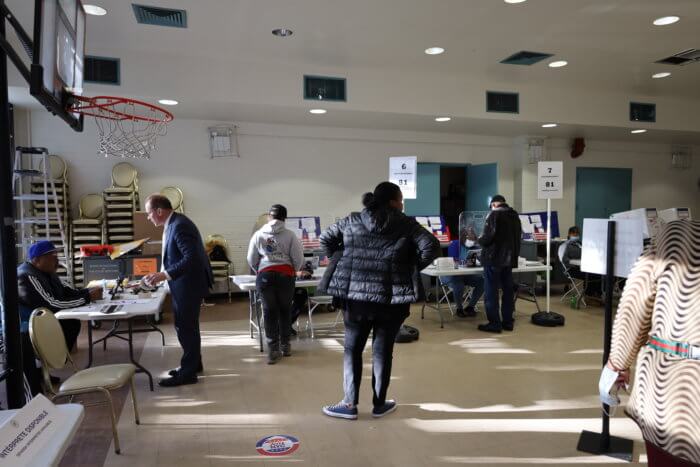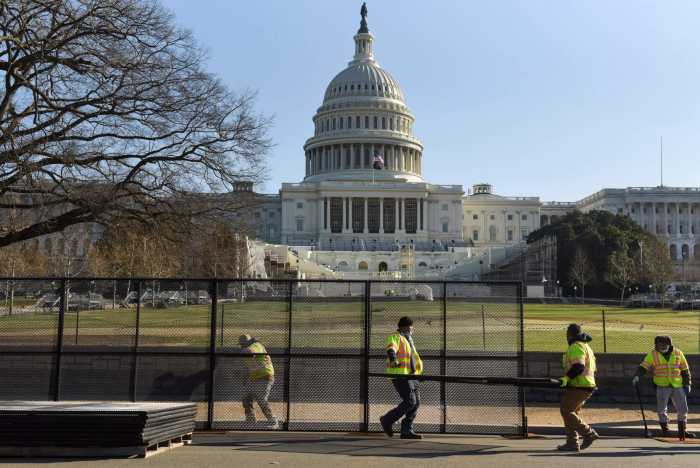Under the rumbling of the passing 6 trains at the Parkchester train station, U.S. Rep. Alexandria Ocasio-Cortez was one of many politicos on Monday doing some last-minute campaigning, rallying Bronx passersby and canvassers to drum up voting enthusiasm when polls open on Election Day.
Ocasio-Cortez didn’t have a dramatic Tuesday, as she cruised to victory over Republican challenger Tina Forte for a third term as the Bronx’s 14th Congressional District seatholder. But the domino effect of Tuesday’s midterm elections — a better-than-expected Democratic performance — left control of the U.S. House and Senate up in the air entering Thursday morning, leaving many, including AOC, to wait days, if not weeks, for the new makeup of Congress.
Democrats hope to hold onto control of their razor-thin margins and entering Thursday the configuration of Congress is still unclear. The reality of whether or not Democrats retain control will likely impact the progressive’s third-term strategies.
“A lot of (voting in the midterms) really depends on what the core issue is, like what’s top of mind for them,” Ocasio-Cortez told the Bronx Times. “I think if what’s top of mind for you is public safety, then it’s important to know that it was Democrats who passed the most comprehensive gun reform legislation to get guns off the streets in 30 years.”
While Republicans could end up with 219 or 220 seats — a narrow majority as predicted by national outlets — in the House, they came into this midterm election cycle hoping for more, notably midterm blowouts and full control of the Senate. On the flip side, Democrats defied historical odds on Tuesday — the party in power typically sheds an average of two dozen or so seats in the midterms — and will eagerly await the results of Georgia’s clash between incumbent Raphael Warnock and Herschel Walker, which will now be decided by a runoff election in four weeks.

A total of 35 seats in the Senate were up for election Tuesday — 12 Democratic seats and 23 Republican seats. Democrats control the 50-50 chamber by virtue of Vice President Kamala Harris’ tiebreaking vote.
Although none of the Bronx’s four congressional races were particularly close, change in the makeup of the House could alter the next two years for Joe Biden’s presidency and hopes for reelection in 2024.
“Best case scenario for Dems is holding onto the House and Senate, but the more likely case is them only losing by a small margin. For Republicans, picking up those extra seats are likely to help them implement some of their federal level plans,” said Amani Wells-Onyioha, operations director for Sole Strategies, a Democratic campaigning organization. “Best case for Americans is the Dems holding onto power a little longer so Biden can finally get some of his agenda completed.”
In battleground senatorial races like Pennsylvania and Wisconsin, crime had become a major polling point for Republicans and independents, and also played a part in the battle for New York governor between incumbent Kathy Hochul and Long Island Rep. Lee Zeldin.
While midterm elections typically track low for voter participation, Ocasio-Cortez said Tuesday’s midterms had too much at stake for voters to sit out. Young voters showed up in droves to the polls on Tuesday, and had the second highest voter turnout among voters under 30 in at least the past three decades.
About 27% of voters between the ages of 18-29 cast a ballot in the midterm election this year, according to an early estimate from the Center for Information and Research on Civic Learning and Engagement at Tufts University, also known as CIRCLE.
“The stakes are way too high for us to sit this one out but I want to make sure that we don’t talk about what is wrong and what we’re voting against,” said Ocasio-Cortez. “Let’s talk about what we’re voting for … the communities we’re fighting for.”
While the most pressing issue for registered voters in the elections was still the economy, 61% of those surveyed by the Pew Research Center said violent crime is “very important” in shaping how they’ll vote. Black voters are most concerned, with 81% citing crime as their top issue.
“I do have a concern about crime. And I don’t know if it’s because I’m seeing more stories about it, but how do I grapple with that insecurity,” said Marc Roush, an independent voter who said Tuesday that he planned to vote Republican in New York’s governor’s race, but is more mixed on down-ballot contests. “But, I also don’t want to elect people who are parroting what these parties want us to hear.”

AOC and other Democrats have pushed back against the framing of midterm Republicans’ message on crime, nothing that Democrats have been at the forefront of public safety efforts.
Meanwhile, much of the Democrats’ messaging has centered on fear of a Republican-controlled Congress imperiling American democracy.
In 23 states where Republicans hold unified control of the governorship and state legislatures, new laws have been implemented imposing new restrictions on voting, banning or limiting access to abortion, retrenching LGBTQ rights and removing licensing and training requirements for concealed carry of firearms.
AOC first rose from political unknown to newly elected congressmember in 2018, beating entrenched incumbent Joe Crowley in that year’s midterms. Since then, she has elevated her status as the one of the nation’s leading progressives in Congress.
In 2020, she defeated a field of primary challengers — Michelle Caruso-Cabrera, Badrun Khan and Sam Sloan — receiving 75% of the total vote. Her last general election was also a lopsided contest, when she defeated Conservative John Cumming by a 71%-27% margin.
Now set to enter her third term, AOC hopes it will include taking a systemic approach to housing — recently detailing efforts on the federal level to create additional housing amid a national housing crisis — as well as Medicare For All and more systemic policies on environmental justice.
One of the Congressmember’s big victories was an effort to cap the price of insulin, which was signed into law as a part of the Inflation Reduction Act, and goes into effect next year.
“I do think it’s always great because there is a really high contrast between how things are portrayed in media, how I can be portrayed in media versus what the reality is. And so I always relish that opportunity, but also, I always just relish that opportunity to be able to build community here,” said Ocasio-Cortez. “Sometimes people, not just constituents, but this community knows me better than most people in the country. I get a lot of shock sometimes from my Republican colleagues that kind of really believe all these things (said about me), and they’ll strike up a conversation and come way with different perspective.”
Reach Robbie Sequeira at rsequeira@schnepsmedia.com or (718) 260-4599. For more coverage, follow us on Twitter, Facebook and Instagram @bronxtimes





















